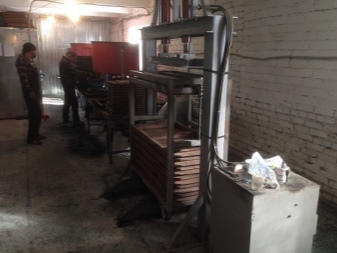Production methods
To make tiles from crumb rubber, you will need special equipment and premises. The latter should be at least 100 m2 in area, moreover, heated - in the cold period, the temperature in it should not fall below +5 degrees Celsius.
The main focus is on the means of manufacturing rubber panels. The initial amount that will be required to start will depend on their quality and power. You can buy everything separately, but it is better to purchase the complete line as an assembly. This will facilitate and unify the process.

Now for this, various kits are offered, but at least you will need:
- mixer - for mixing various components;
- ovens - for drying products;
- hydraulic press - to form products;
- forms;
- conductor - for punching holes for connecting elements;
- forming table and fixing stand.
This is the most necessary equipment for the deployment of production. With its help, it is already possible to start producing coatings based on crumb rubber of various thicknesses and sizes.
At the moment, slabs are made in three different ways.
Cold
This method is considered classic, it was developed by the very first and is already considered obsolete.
The process consists of 2 stages. Thoroughly mixed in a mixer, the mixture is poured into selected forms, located on a special table. Then there is pressing under high pressure (about 5 tons) and transfer to a drying oven, where at a temperature of 55-60 ° C the products are dried for at least 6 hours. Then the molds are disassembled - and the product is ready for use.
This method has the following advantages: the equipment is widespread and available, and tiles can be produced on a small scale.
The disadvantages include the need to constantly monitor the process, a fairly large percentage of defects and a high price.


Hot
The hot pressing method is considered to be the most progressive. The first stage coincides with the previous method, and the difference is in pressing the panels. The prepared composition is placed in metal molds, heated to a temperature of + 120 ... 220 ° C and simultaneously pressed.
Based on the parameters of the product, the process takes from 3 to 20 minutes. During this time, the adhesive spreads evenly over the mixture, creating a more reliable bond between the rubber crumbs. This technology makes it possible to obtain tiles with better characteristics than with the cold method.
Advantages: a wide range of products, low cost, excellent quality of panels and a small percentage of defects in production.
There are also disadvantages: the equipment is quite expensive, and the workers must have the appropriate qualifications.


Thermochemical
This is the newest method that allows you to get products that meet all requirements, even the most stringent ones. The difference from the first two technologies is that, if necessary, it is possible to set the required parameters. In other words, products from the same material can have different indicators of density, hardness, elasticity and other parameters.
The process goes like this:
- crushed rubber is mixed with glue;
- depending on the requirements, the necessary components are added to the panels;
- placement in molds, heating and pressing takes place (it may take from 2 to 10 minutes).
Upon completion, we receive products of the highest quality, ready for use.
The advantages are the same as with the hot method, plus the ability to manufacture specialized types of coatings
The disadvantages also coincide, and in addition, you need to constantly monitor the production process with special attention.


